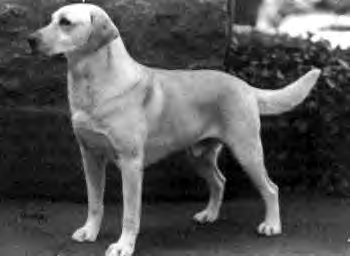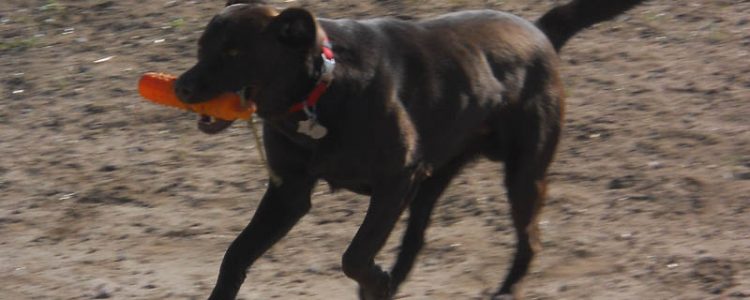We had a great weekend – despite the heat and wind near Boone, CO. Arwen passed a tough Finished test, Tory passed his 3rd Seasoned test, and Jazzy got to run two Started tests and passed both!
The Finished test started with a wide-open triple “dove” hunt and a diversion as the dog was coming in with the last bird. Then a blind retrieve with lots of suction to the dike and old falls. Arwen did fabulously! I, on the other hand, “missed” every bird I shot at.
Afterward we decided to try for ducks. This series was a mind-bender of trying to remember which bird is shot at by which handler and which dog gets to retrieve.
It started off with a buddy on the honor bucket with his dog as Arwen and I walked down the muddy path to the pond. On the way, a duck comes sailin’ in from the left. Both handlers take a shot at it, but remembering not to shoot in the direction of the other handler! The honor dog picked up that bird while the working dog had to watch.
Once we got settled on a bucket, a duck came in from over our right shoulder and quickly thereafter another duck came in from the left. Both handlers shot at the birds. Arwen picked up the left bird after a long swim and then rooted the right bird out of the reeds.
Somehow with all that “shooting” we put down another bird way off to the left. The line to the blind was just off the beach with suction to the shore and to the old fall. Couple whistles and Arwen picked up that bird.
Time for a new “buddy.” As he came down the path with his dog, we moved to the honor bucket. But this dog was amped! When he came into sight Arwen must have figured she’d need a headstart to beat him to HER birds and took a few steps toward the water during the double, but luckily decided not to go any further! Good dog!
I had an interesting experience a couple of years ago. I was at a dog show and noticed a booth for an animal communicator. I pooh-poohed it at first, but then thought ‘what the heck.’
At first her ‘communications’ were pretty generic – things like Chip (my dog) wanting to know how long Labs live, that he was glad that I take good care of him, that he wants his granddaughter to take his place after he’s gone, etc.
Did I really believe she was talking to my dog? Not at first, but something she said turned me into a believer on the way home. She told me that Chip was my self-appointed protector and he wanted me to get a new truck so I could see out of it. It didn’t make much sense at the time. On the way home, though, Chip was in the front seat with me and he was sitting on the passenger seat when I wanted to change lanes. I glanced over and told him, “Lay down, I can’t SEE.” When I realized how often I say that, I became a believer.
I used to be a vet tech and blithely gave vaccines to all my animals. DHLPP for dogs, seven-way for horses, FeLP for cats. The veterinarians said they would keep my animals healthy and I believed.
Then I heard about the feline leukemia vaccine causing cancer in cats. I thought it would be better not to give this vaccine, but the Association of Feline Practitioners said to give it anyway – just give it in the cat’s rear leg.
Why, you ask? That way when the cat developed cancer they could just amputate the leg. For more information see: https://www.vetinfo.com/feline-leukemia-vaccine.html Where they say, “By limiting the vaccination site to the back leg, amputation is a better idea.”
The more I thought about it, the more I distrusted the use of vaccines. Inject a small dose of the disease directly into an animal and hope their immune system could deal with it? How unnatural.
Then to increase the efficiency, the drug makers started adding adjuvants. These are substances that the World Health Organization listed as Class III carcinogens with Class IV being the highest risk. (IARC Monographs on the Evaluation of Carcinogenic Risks to Humans: Volume 74, World Health Organization, International Agency for Research on Cancer, Feb. 23-Mar. 2, 1999, p. 24, 305, 310.)
Although required by law, the rabies vaccine is one of the most dangerous of the vaccines. Researchers believe it causes the most and worst adverse reactions in animals, including cancerous tumors at the injection site. Here is a webpage I came across recently that chronicles the decline and eventual death of an Australian Shepherd after her second rabies vaccination. http://www.pinecrest-aussies.com/in-memory-of-belle.html
There is a study underway to improve the safety of rabies vaccines and to determine, by challenge, if they confer immunity for longer than three years as currently believed by most states. One French study showed dogs were immune to a rabies challenge five years after vaccination, while a study in Wisconsin found sufficient antibody titers after seven years. The current study, the Rabies Challenge Fund, is about to start its third year, but is short on funds. Please consider making a donation today! This is a 501(c)(3) charitable organization. Their website is www.RabiesChallengeFund.org
UPDATE – January 25, 2018
Research shows that dogs who have received two doses of rabies virus vaccine are protected for at least FIVE years. The study is still ongoing and they are collecting and analyzing data from 6.5 and 7 years post-vaccination.
Here are links to more information about vaccine dangers:
Veterinarian Quotes
http://www.yourpurebredpuppy.com/health/common/vaccinations.html
Ron Schultz, DVM quoted on Shirley’s Wellness Cafe
http://www.shirleys-wellness-cafe.com/petvacc.htm
Vaccine Safety
http://www.vaccines.net/newpage114.htm
(Updated Apr 4, 2020) English Labs, American, field-type, show dog – how can there be so many different styles of dogs and all be considered Labradors? My guess is that the breed is just too popular – for 28 years now (since 1991) Labs have been the #1 breed in America per the American Kennel Club (AKC). Distinctive styles have evolved to suit everyone’s varying tastes, and I’m not saying that’s a good thing, it just is.
At one end of the continuum are the show dogs – often called “English Labs.” They tend to have heavy bodies, blocky heads and short legs. I think they’re a product of the more is better syndrome – the standard calls for a broad head, so let’s make it massive, etc. They’re also a product of what wins – a dog wins Best of Breed at a prestigious show and people sign up in droves to breed to him in hopes of duplicating him and his wins. Unfortunately some of these dogs have become caricatures of the original Labs who were bred to be field dogs. A 100-pound, 22″ dog with profuse coat wouldn’t be my first choice to chase wild ringnecks in South Dakota. That said, I am seeing a shift to a more moderate dog in the show ring, except for the Labrador-only specialty shows where structure is generally excellent, but more-is-better still reigns.
At the other end are the field dogs – often called “American Labs.” They tend to be tall and slender with whip-like tails, skinny heads and lots of energy. These dogs can spend all day hunting or running multiple marks at tremendous distances and still want more. They too are products of the more is better and the whatever-wins syndromes. These dogs are generally bred for their abilities rather than their looks – trainability, marking ability, and intelligence. These breedings are all about trying to produce field trial winners with less regard for the dog’s structure or appearance. However there are some field-bred dogs who still look like a classic Labrador – dogs from early in the breed’s history up until the breed really started to diverge in the 1960s.
I’ve seen an adult female Lab who had the height, bone structure and even head shape of a Whippet. I’ve also seen an adult male Lab who had heavy bone, massive head, thick coat and, except for the height difference, could have been mistaken for a Newfoundland. Some also have a short muzzle and very deep stop (where the tops of the skull and muzzle meet) that reminds me of a Neanderthal. No joke!
To be fair, dogs from both ends of the continuum fill particular needs and are loved and cherished by their owners. Plus there are many dogs that fall somewhere between the two extremes. However the extremes are quite different from the classic Lab – a medium sized dog who loved to retrieve.
I imagine owners of both styles are asked, “What breed of dog is that?” If that’s the case then those dogs are not “typy.” Type equals that which makes a Lab distinguishable from a Golden Retriever or a Rottweiler or a German Shepherd or any other breed. According to the Labrador standard, the “most distinguishing characteristics of the Labrador Retriever are its short, dense, weather resistant coat; an ‘otter’ tail; a clean-cut head with broad back skull and moderate stop; powerful jaws; and its ‘kind’ friendly eyes, expressing character, intelligence and good temperament.”
Here are a couple of classic Labs:
First, is Dual CH-NFC-AFC-Can CH Shed of Arden, (the black dog) a great Lab of the past. He not only earned a show championship in two countries, but was also a three-time National Field Champion! Shed was not so tall and lanky as many of the field dogs of today, nor was he so blocky as most of the current show dogs.


Another great from the past was CH Shamrock Acres Light Brigade. “Briggs was an outstanding show dog and sire. He produced 93 AKC Champions and won 12 Best in Show awards and 75 Sporting Group placements.” Compared to show dogs today he had way more leg and less substance, but look at those shoulders and the balance! I’d bet he moved exceptionally well.
By the way, most of my dogs have both of these famous boys in their pedigree!
I am happy to see some progress – or at least interest – in returning to the moderate Lab, one not overdone or underdone in body style and that still has the desire to retrieve. We call these dogs Dual-Purpose Labradors.
A well-respected, long-time show breeder told me recently that the dog can be pretty, but MUST have the desire to retrieve to be a true Lab.

I’m trying to work with Breaker a little each day though it’s tough to do all this with just the knowledge I’ve gotten from Joe, Brian and yourself. I’m trying as best I can! I hope to see you again soon!!
Sarah
Hi Sarah –
For Breaker, just keep working on the basics. Work on obedience – heel, sit, come and down. You can do this at home.
Throw marks in different areas and different lengths (watch out for snakes). If he has any trouble with longer marks, see if you can get someone to help by throwing.
Pick out a nice place with fairly short cover and at least 100-150 yards of open area. Have your thrower stay at the same place while you move back with each throw. Start at a distance a little shorter than his best comfort zone – maybe 30 yards – have him sit while the thrower tosses the bumper.
As Breaker picks it up, you back up about 5-10 yards while encouraging him to come to you. Throw the same mark again and run him from this longer position. If he’s doing well, back up another 5-10 yards as he’s coming to you.
Do 3-4 of these at every opportunity and gradually increase the distance. When he’s comfortable out to 150 yards or so on short cover, go back to the shorter distance (30 yards +/-) but this time in higher cover and start increasing the distance again. Probably best to increase by a shorter amount each time because finding bumpers in cover is much more challenging.
Also work on his steadiness. Hold his collar, but require him to sit still and quiet until you release him.
When he’s doing really well and you think he won’t break, slip a short (~ 2′) length of cord like clothesline through his collar and hold both ends with slack in it so he doesn’t feel you holding him. If he breaks, stop him with the cord and have the thrower pick up the bumper. Try again. Only release him for the retrieve if he stays steady. Also vary the amount of time he has to sit after the bumper lands (1 or 2 seconds up to 6 or 7 seconds on occasion).
Also vary the type of ground and cover you work him on. For example, use a ballfield for increasing distance with short cover. Then try to find some place with plenty of cover.
Look for a small ditch – but make sure it’s very visible to him. Look for a creek or pond. Look for a hillside and throw marks up, down and across (not in the same session tho).
Try throwing downwind and crosswind marks (not into the wind because he will smell the bumper early and could start quartering). Basically give him experience picking up bumpers and birds in as many situations as you can find.
When he’s doing well and has all his teeth in – he should by now – you can start on force fetch. Some dogs will need to stop picking up marks until force fetch is completed just because they get pissy over HAVING to pick up something. Other dogs don’t care.
Just make sure once you start force fetch you see it through to the end, otherwise the dogs wind up learning they don’t have to fetch and won’t fetch unless they feel like it. Tough to correct!
Hope to see you soon!
Although a little belated, I want to give Chip a pat on the head via the Internet for completing 12 titles – obedience, rally, tracking and field.
He’s also working on some basic agility – I just need to work on keeping up with him.
Way to go Chip!
HRCH Justamere Chocolate Chip CD TDX SH RAE CGC



